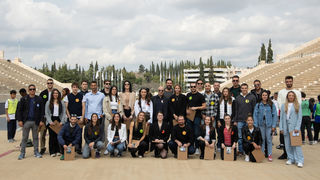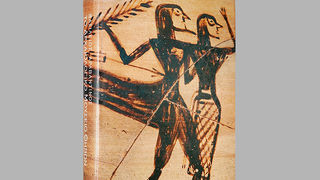DATE
02 Dec '10
This year, the rich history and art of Boeotia from the Palaeolithic up to and including the Byzantine Era and the treasures that have on occasion been found in Boeotia’s soil come to life in the book funded and published by the John S. Latsis Public Benefit Foundation and Eurobank EFG, entitled ''The Archaeological Museum of Thebes''. This twelfth addition to ''The Museums Cycle'' series was presented at the ''Pallas Athena'' Building, the premises of the John S. Latsis Public Benefit Foundation, on Thursday, December 2, 2010.
In her speech, Marianna J. Latsis, noting the general context in which the current publication is being presented, underlined that
“maintaining a balance between the need to constantly display and promote Ancient Greek culture and the even more imperative need to variously support contemporary Greece, the John S. Latsis Public Benefit Foundation strives, every day, to adapt its activities to face the new challenges. We do not seek to make safe and obvious sponsorship choices that will simply boost the status and credibility of our Foundation. We are particularly interested in staying in touch with current events, and we are pursuing new and innovative ways of engaging the public in a two-way communication, frequently supporting groundbreaking programmes.”
She added that:
“The book we are presenting today, dedicated to the Archaeological Museum of Thebes, fits harmoniously with the Foundation’s objectives. I truly hope this volume will be of some small assistance to the renovated Archaeological Museum of the city of Thebes, which will very soon open its doors, in achieving both the recognition and the place it deserves in the mosaic of the archaeological museums of Greece.”
In his foreword to the book, Culture and Tourism Minister Pavlos Yeroulanos stressed that
“this book will contribute to the effort to highlight the wealth of the museum, in the hope that it will function as a supplement to the work of the re-exhibition, which will modernize the museum and make it more accessible to its public. This collaboration has enormous value because the way in which the world perceives who we are and what our identity is depends not only on contemporary Greek creation but also on the way we publicize our heritage.”
In his speech, Alternate Minister of Culture and Tourism Tilemachos Chytiris remarked that
“19th and 20th century Greece had two paths to follow to create its identity in the contemporary world. A journey through time, to the past, to ancient Greece and the legacy of its values (democracy, philosophy, art) and another path towards its future. These two paths, leading in opposite directions, are essentially one. Greece sustains the present and the future through its historical past as well. The present is in crisis. The past is unchanging and assists through its presentation and promotion. Apart from the efforts of the Ministry of Culture and Tourism, which correctly links culture with tourism, there exist members of the private sector, such as the John S. Latsis Public Benefit Foundation and Eurobank EFG, who contribute greatly to this effort.”
Eurobank EFG Chief Executive Officer Nikos Nanopoulos stressed that
“at this present juncture, the importance of subsuming individual imperative to the common good as a way of life has a specific weight. Because when public morality shapes individual behaviour, then people are capable of great feats and societies are able to develop and prosper. Contribution, self-denial, a sense of duty, discipline, falling in line with the needs of Greece, all these are values that, today, are once again agonizingly appropriate. The history of Thebes, depicted through our present volume, reminds us that Greek civilization bequeathed these values to humanity’s global society. Today, we Greeks must look to these values once again and use them as our compass in the enormous effort Greece—Greek society—is undertaking to emerge from the crisis and construct the future it deserves, a future of development, progress, and prosperity.”
In his speech the author, 9th Ephorate of Prehistoric and Classical Antiquities Director Vassilis Aravantinos, stressed that
“Boeotia’s historical and artistic progress throughout the millennia is now presented in the pages of a book, preparing us for its future exhibition. The images appear three-dimensional; the antiquities are resurrected and converse familiarly, for the first time, among themselves and with us. This resurrection continues in the Museum of Thebes, with its steady progress towards a new exhibition of its ancient and medieval collections.”
He added that
“the presentation, prior to its opening, of the museum’s priceless treasures in a volume devoted to them, along with their simultaneous posting on the internet so as to reach every corner of our world, is both startling and pleasantly surprising. The comprehensiveness, the significance, and the quality of the Boeotian antiquities assuredly justify going beyond standard practice. The selection of the book’s ‘antiquities’ was not made from the display cases of a museum that is ready and open to the public, but from a host of equally worthy and dissimilar works, invaluable cultural relics many of which are destined for an anticipated, and already in the process of taking place, re-exhibition.”
The Archaeological Museum of Thebes is a luxurious 400-page publication illustrated with a total of 671 photographs. Eirine Louvrou of Olkos Publishing had the overall supervision of the book. Dimitris Kalokyris was responsible for the design and artistic supervision. The photographer was Sokratis Mavrommatis. The book was printed by Fotolio & Typicon SA; colour separations were by Indigo Graphics SA, and binding by K. Stamou and Company. The text was translated into English by Judy Giannakopoulou.
As it does every year, The John S. Latsis Public Benefit Foundation will distribute copies of the new volume of ''The Museums Cycle'' series to the archaeology departments of various Greek and foreign universities, foreign archaeology schools and institutes in Greece, and departments of the Hellenic Ministry of Culture and Tourism, as well as to selected libraries in Greece and abroad.
The book is also available in digital format in Greek and English through the Foundation’s electronic library, accessible by clicking here.
RECENT NEWS

Olympic Preparation Scholarship Programme | Public Call 2025-2026
15 Dec '25

Protovoulia ‘21: Presentation of the Action Plan on Climate Crisis and the Environment – Establishment of a Model Centre for Dementia and Alzheimer’s Disease
31 Oct '25

“Thriassio” General Hospital of Eleusis | Anniversary Event “Latsiο Burn Centre 2005–2025: Contribution to Humanity”
10 Oct '25
